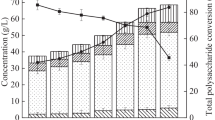Abstract
Interest in the production of lactic acid (LA) is increasing inrelation to its applications in the synthesis of biodegradablepolymer materials. Before kitchen waste is used as substrates inLA fermentation, it must be stored for some days in the wastecollection system. This study examined the effects of pHadjustment including initial pH before the storage in terms of thekind and the amount of added acid on preservation of the waste. The optical purity of LA generated during the storage was alsoanalyzed. It was found that antibacterial activity andsuppression ability to D-lactic acid (D-LA) were stronger in theorder: acetic acid > L-lactic acid (L-LA) > hydrochloric acid ≈ nitric acid. The optimum condition of waste storage was found to be adjusting initial pH to 3.4 by adding acetic acid. It can be expected that preservation of kitchen waste can be realized by inhibiting the growth of putrefactive bacteria, and higher optical purity of L-LA was obtained by adding weak acid to the waste.
Similar content being viewed by others
References
APHA: 1980, Standard Methods for the Examination of Water and Wastewater, 15th ed., American Public Health Association, New York.
Bureau of Living Hygiene, the Ministry of Welfare of Japan: 1990, ‘Standard Methods of Analysis in Food Safety Regulation (Biology)’, Japan Food Hygiene Association, Tou Kyou.
Callewaert, R. and De Vuyst, L.: 2000, ‘Bacteriocin production with lactobacillus amylovus DCE 471 is improved and stabilized by fed-batch fermentation’, Appl. Environ. Microbiol. 66, 606-613.
Dubois, M., Gilles, K. A., Hamilton, J. K., Rebers, P. A. and Smith, F.: 1956, ‘Colorimetric method for determination of sugars and related substances’, Anal. Chem. 28, 350-356.
Fukushima, T., Wang, Q. H., Narita, J., Kakimoto, K., Shirai, Y. and Ogawa, H. I.: 2001, ‘Studies on Generation of Lactic Acid from Kitchen Garbage: Preservation and Deodorization of Stored Garbage by pH Adjustment’, Proc. 35th Annual Conference of the Japan Society on Water Environment, Gifu, 2001, p. 101.
Lipinsky, E. S. and Sinclair, R. G.: 1986, ‘Is lactic acid commodity chemical?’ Chemical Eng. Prog. 82, 26-32.
Oda, Y., Park, B.-S., Moon, K. H. and Tonomura, K.: 1997, ‘Recycling of bakery wastes using an amylolytic lactic acid bacterium’, Biores. Technol. 60, 101-105.
Ohara, H.: 1994, ‘Poly L-lactic acid as biodegradable plastic’, Biosci. Industry 52, 26-28.
Sakai, K. and Shirai, Y.: 2000, ‘Selective proliferation of lactic acid bacteria and accumulation of lactic acid during open fermentation of kitchen refuse with intermittent pH adjustment’, Food Sci. Technol. Res. 6, 140-145.
Sasaki, H., Li, Y.-Y., Skei, K. and Kamigochi, I.: 1995, ‘Effects of hydraulic retention time and loading rate on high-solide thermophilic methane fermentation of the organic fraction of municipal solid waste’, Nippon Mizukankyou Gakaisi 18, 875-882.
Schmidt, S. and Padukone, N.: 1997, ‘Production of lactic acid from wastepaper as a cellulosic feedstock’, J. Induct. Microbiol. Biotechnol. 18, 10-14.
Shirai, Y.: 1999, ‘Lactic Acid Production from Urban Refuses’, Proc. Asia-Pacific Chemical Reaction Engineering Symposium, Hong Kong, 1999, pp. 383-386.
Thimann, K. V.: 1963, The Life of Bacteria, Mac Millan, p. 168.
Wang, Q. H., Noguchi, C., Hara, Y., Sharon, C., Kakimoto, K. and Kato, Y.: 1997, ‘Studies on anaerobic digestion mechanism: Influence of pretreatment temperature on biodegradation of waste activated sludge’, Environ. Technol. 18, 999-1008.
Wang, Q. H., Kuninobu, M., Kakimoto, K., Ogawa, H. I. and Kato, Y.: 1999a, ‘Upgrading of anaerobic digestion of waste activated sludge by ultrasonic pretreatment’, Bioresour. Technol. 68, 309-313.
Wang, Q. H., Kuninobu, M., Ogawa, H. I. and Kato, Y.: 1999b, ‘Degradation of volatile fatty acids in highly efficient anaerobic digestion’, Biomass Bioenergy 16, 407-416.
Wang, Q. H., Yamabe, K., Narita, J., Morishita, M., Ohsumi, Y., Kusano, K., Shirai, Y. and Ogawa, H. I.: 2001, ‘Suppression of growth of putrefactive and food poisoning bacteria by lactic acid fermentation of kitchen waste’, Process Biochem. 37, 351-357.
Wang, Q. H., Narita, J., Xie, W. M., Ohsumi, Y., Kusano, K., Shirai, Y. and Ogawa, H. I.: 2002, ‘Effects of anaerobic/aerobic incubation and storage temperature on preservation and deodorization of kitchen garbage’, Bioresource Technol. 84, 213-220.
Woiciechowski, A. L., Soccol, C. R., Ramos, L. P. and Pandey, A.: 1999, ‘Experimental design to enhance the production of L-(+)-lactic acid from steam-exploded wood hydrolysate using rhizopus oryzae in a mixed-acid fermentation’, Process Biochem. 34, 949-955.
Xiaodong, W., Xuan, G. and Rakshit, S. K.: 1997, ‘Direct fermentative production of lactic acid on cassava and other starch substrate’, Biotechnol. Lett. 19, 841-843.
Author information
Authors and Affiliations
Corresponding author
Rights and permissions
About this article
Cite this article
Wang, Q., Narita, Jy., Ren, N. et al. Effect of pH Adjustment on Preservation of Kitchen Waste Used for Producing Lactic Acid. Water, Air, & Soil Pollution 144, 405–418 (2003). https://doi.org/10.1023/A:1022919716627
Issue Date:
DOI: https://doi.org/10.1023/A:1022919716627




